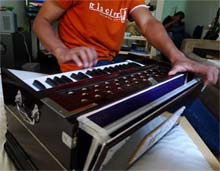HARMONIUM
History
In India the harmonium or reed-organ, or "the poor man`s pipe-organ," belongs to the same family of instruments as the mouth-organs and accordion-type instruments. It has freely moving reeds (as well as rising reeds) on which a patent was taken out in 1840 by the French instrument maker, Alexandre Debain.It became an extremely popular instrument in the United States and Europe in the second half of the nineteenth century, used mainly for accompanying the voice in the home and in church, since it had the tone of a pipe-organ without the bulk or the enormous expense.
The harmonium has a piano-like body which usually is elaborately carved in the fashion of the day. Harmonium has two foot-pedals connected to two bellows that provide air supply and keyboard has a range of five octaves. Below the keyboard there are two siphon paddles operated by the player`s knees. One initiates sort of swells mechanism while the other is used for musical emphasis like a general crescendo.

Brief Introduction
Harmonium usually belongs to the family of free-reed aerophones. The instrument is a small, tabletop size, organ which has bellows at the back that is pumped by one hand while the other hand plays the keyboard. A standard Harmonium always has a wooden box known as body, handles to move the instrument, bellows, keys, stops (main and drone), reeds, reed board, coupler and scale changer. Today in India it is widely used in all forms of Indian music be it classical, Hindustani, devotional or film music. A high quality Harmonium with full sound range and keyboard has 39 keys and thus supplies a tonal range of 3 octaves, 4 adjustable drones are possible. The Double reeds make sure that every tone is supplied with two reeds (for medium and lower octave). Three variations with different settings can be achieved by blowing the reeds either separately or together.How to play a Harmonium
For playing harmonium, a sitting position must be followed which should be a standard sitting position where the harmonium is placed on the ground. A right handed player uses the right hand for the keys and the left hand for pumping the bellows. It is the most preferred position in India. The other position is the qawwali where the harmonium rests partly on the player's lap and partly on the floor. In some cases, the harmonium is worn around the neck using a strap. In this case, the harmonium can also be played as the player is standing and walking.Popular Musicians

Importance
The popularity of the Indian harmonium had many people believing that it had originated from the country. When the British brought the instrument to India, the foot pedal stayed; however, a hand-pump version was introduced in India it self. This was beneficial for the Indians as they primarily sat on the floor to play their instruments. Often Indian musicians sing while playing their instruments, and the harmonium sounded well with vocals. Indian music generally is melodic, and musicians usually don't play chords on their instruments. Since Indians only needed one hand to play individual keys on the instrument, they had a free hand to pump air, making the whole process of using the harmonium easy to learn.Where to learn to play a Harmonium
TARANG School for Classical Indian Dance and MusicManager: Marie-Luise Siebenkaes
Johannisstrasse 14D-90763 Fuerth
Germany Telephone: +49-(0)911-6708040
Fax: +49 (0)1212-512616701 USt-IdNr.: DE228189973
Where to buy a Harmonium
Contact: Mr Ashish ShrivastavaSathyadeep Musical Palace
Beside Vysya Bank
Post- Puttaparthy
Dist-- Anantapur
Andhra Pradesh Pin- 515134
INDIA
[email protected]
[email protected]


